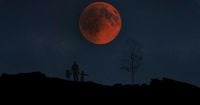The skies above Scotland are once again preparing to put on a celestial show, as a rare and breathtaking lunar event is set to unfold in the coming weeks. Stargazers, amateur astronomers, and anyone with a sense of wonder about the universe will want to mark their calendars for Thursday, September 7, 2025. On this evening, Scotland will witness a total lunar eclipse, commonly referred to as a "Blood Moon," when the moon takes on a haunting orange or red hue as it slips into Earth's shadow.
According to the BBC, this will be the second lunar eclipse visible in the UK this year, following closely on the heels of the mesmerizing Perseid meteor shower that lit up Scotland's night skies earlier in August. For those who missed that stellar spectacle, the upcoming Blood Moon offers another chance to marvel at the cosmos—and this time, the experience promises to be just as unforgettable.
But what exactly is a lunar eclipse, and why does it turn the moon such an unusual color? In simple terms, a lunar eclipse occurs when the Earth moves directly between the sun and the moon. This alignment causes the Earth to cast its shadow across the lunar surface. During a total lunar eclipse, the moon passes completely into the darkest part of Earth's shadow, known as the umbra. As sunlight filters through Earth's atmosphere, shorter blue wavelengths scatter, while longer red and orange wavelengths bend toward the moon, bathing it in a coppery glow. It's this phenomenon that gives rise to the evocative term "Blood Moon."
Royal Museums Greenwich has laid out the timeline for this celestial event in detail. The moon is due to rise above the Scottish horizon just as the total lunar eclipse is set to begin. The maximum phase of the eclipse will occur at 7:33pm British Summer Time (BST), though the actual maximum—when the moon is deepest in Earth's shadow—will take place slightly earlier, at 7:11pm, when the moon is still below the horizon for much of the UK. From there, the spectacle will continue as the moon gradually emerges from Earth's shadow, with the event drawing to a close at 9:55pm BST.
For those eager to catch the Blood Moon at its most dramatic, experts recommend seeking out a high vantage point with an unobstructed view to the east. Hills, cliffs, or open fields can provide the best sightlines, allowing viewers to watch the moon rise and witness the eclipse in all its glory. Of course, as with all astronomical events, the weather will play a crucial role. Clear skies are essential for an unhindered view. If clouds roll in, the moon's transformation may be hidden from sight, much to the disappointment of hopeful onlookers. Still, even a fleeting glimpse of the Blood Moon can be a thrilling experience.
This lunar eclipse is particularly notable for being the second to grace the UK in 2025, a year that has already proven to be a banner one for celestial phenomena. The earlier Perseid meteor shower, well-known for its bright and frequent shooting stars, captivated observers across Scotland just weeks ago. Now, the Blood Moon offers another opportunity for communities to come together under the night sky, sharing in the awe that such rare events inspire.
For those new to skywatching, a lunar eclipse is perhaps the most accessible of all astronomical events. Unlike a solar eclipse, which requires special eye protection and careful timing, a lunar eclipse can be viewed safely with the naked eye. No telescopes or binoculars are necessary—though they can certainly enhance the experience, revealing subtle details on the moon's surface as it darkens and glows with color. The only real requirements are curiosity, a clear eastern horizon, and a bit of patience.
The cultural resonance of the Blood Moon stretches back centuries. Across the world, lunar eclipses have sparked myths, legends, and scientific inquiry. In ancient times, the sudden transformation of the moon was often seen as an omen or a sign from the gods. Today, while science has demystified the mechanics behind the event, the sense of wonder remains undiminished. For many, witnessing a Blood Moon is a reminder of our planet's place in the solar system, and of the intricate dance between Earth, moon, and sun.
According to Royal Museums Greenwich, "the maximum will occur at 7:33pm BST from the UK, with the eclipse's actual maximum at 7:11pm when the moon is below the horizon." This timing means that while the eclipse will already be underway as the moon rises, viewers in Scotland will still have ample opportunity to observe the moon as it emerges into the visible sky, gradually moving out of Earth's shadow until nearly 10pm. The extended duration of the event allows for flexibility—those unable to catch the beginning can still enjoy the later phases.
It's worth noting that the visibility of the Blood Moon is not uniform across all regions. In Scotland, with its northern latitude and often unpredictable weather, the experience can vary from place to place. Urban light pollution can also dim the spectacle, making rural areas or designated dark-sky sites especially attractive for serious observers. Scotland, in fact, boasts some of Europe's best stargazing spots, as highlighted by recent travel guides and astronomy enthusiasts alike.
For those planning to venture out, a few practical tips can help make the most of the night. Dress warmly—September evenings in Scotland can be chilly, especially in exposed locations. Bring a blanket or a folding chair for comfort, and consider packing a hot drink. Arriving early not only ensures a good spot but also allows time for your eyes to adjust to the darkness, enhancing your ability to see subtle changes in the moon's color and brightness.
While the Blood Moon is the main attraction, the evening may offer other delights as well. Depending on the clarity of the sky, planets such as Jupiter or Saturn may be visible, along with a scattering of late-summer constellations. For families and friends, the event is a chance to disconnect from screens and reconnect with the rhythms of nature—a shared moment of wonder that transcends age and background.
As the eclipse unfolds, social media will likely light up with photos and reactions from across Scotland and beyond. The communal aspect of skywatching, amplified by modern technology, means that even those unable to see the event firsthand can share in the excitement. But for those able to step outside and look up, the Blood Moon promises an experience that no screen can truly capture—a fleeting, magical transformation of the familiar moon into something extraordinary.
With the date fast approaching, anticipation is building among Scotland's astronomy community and the general public alike. Whether you're a seasoned stargazer or simply curious about the natural world, the Blood Moon of September 7, 2025, is an event not to be missed. Provided the weather cooperates, Scotland's skies will deliver a spectacle that is both scientifically fascinating and profoundly beautiful—a reminder, if one were needed, of the wonders that await just above our heads.




